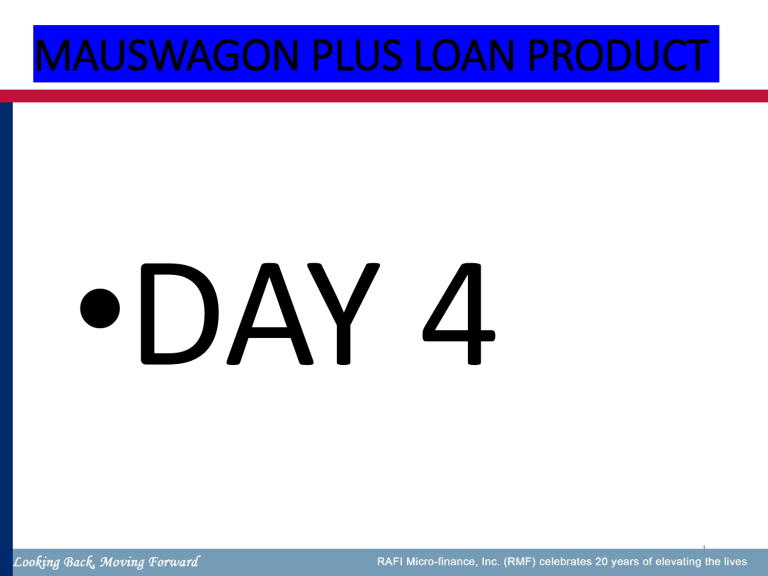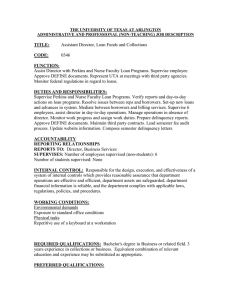
MAUSWAGON PLUS LOAN PRODUCT •DAY 4 1 KPI AND STANDARD CASE LOAD OF MPLUS TS KPI AND STANDARD CASE LOAD TOUCHING PEOPLE SHAPING THE FUTURE LOOKING BACK MOVING FORWARD Key Performance Indicator Target # of Approaches 2/day; 40 per month # of New Loans 5 Conversion Rate 12.5% Number of New Loans per Month 5 Loan Release Size – NL 80,000 Loan Release Size 80,000 Loan Release Size – RL 100,000 Average Term 12 months Caseload to Breakeven 50 Staffing 1 MPlus TS; 1 CE Collection Efficiency 98% Minimum Caseload 60 Loan Loss Provisioning 2% Maximum Caseload 120 Operating Expenses Fin Cost: Breakeven Loan Portfolio P2,501,404 Average Loan Portfolio Size P50,028 Minimum Loan Portfolio P3,000,000 Maximum Loan Portfolio P5,000,000 Collection Efficiency 98% PAR 2% 08/04/2022 Break Even Assumptions Interest on CBU,RemCo Admin: Gasoline, Supplies Motorcycle Permits/Ins Documentary Stamps Repairs, Miscellaneous Capex Laptop for CE, Phablet for TS, Motorcycles, Helmet, Chairs Branch Indirect Cost Main Office Indirect Cost 15% (DH, AH, BM supervision) Assumed at 0% as, incorporated in Branch Allocation CONTENT 09:00-10:00-Introduction/Refresher on Day 3 10:00-10:10-Ice Breaker 10:10-12:00-Understanding on Loan Deliquency 12:00-01:00-Lunch 01:00-01:10-Ice Breaker 01:10-02:00-Mauswagon Plus Form Discussion 02:00-03:00- Review 03:00-03:10- Ice Breaker 03:10-04:00-Review 04:00-04:30-Exam 4 Understanding Loan Delinquency Session Objectives • Understand the basic concepts of zero tolerance and delinquency • Know the costs and causes associated with delinquency 6 What is Loan Delinquency? Any loan with a missed amortization of even one day is a delinquent account. 7 What is Zero Tolerance? • Zero tolerance means NO LEVEL OF DELINQUENCY IS ACCEPTABLE • It is the attitude of the bank management & staff towards loan delinquency – no level of late payment is acceptable. It is an institutional culture in which late payments are totally unacceptable • The bank will aggressively pursue past due clients, whatever the cost, to establish and maintain zero tolerance against loan delinquency. Effects of Delinquency • Loan delinquency can weaken and ruin a lending institution • Unless aggressively controlled, delinquency can spread and worsen – leading to high levels of default • Pursuing the collection of delinquent loans swiftly and aggressively facilitates the development of a strong credit discipline among the clients 9 Characteristics of Delinquency • Delinquencies should be seen as direct costs to the bank • Delinquency and loan losses imply postponed income, lost income and lost portfolio to the bank • Measures aimed at reducing delinquency are costly. 10 What makes loan delinquency distinct from other problems? • Cost of delinquency is hidden • Lenders tend to attribute delinquency to external factors • Delinquency is contagious 11 What are the costs of delinquency to the bank? 12 The Costs of Delinquency • Quantifiable Costs • Non-quantifiable Costs 13 Quantifiable Costs Impact on Bank Impact on Borrower Cost Structure Additional cost • Collection cost • Loan Loss Provision • Legal Fees • Penalties & surcharge • Legal Fees • Increased interest rates Income • Delayed Income • Slower portfolio rotation • Slower portfolio expansion Financial Condition • Decrease in bank’s resources • Impacts on bank’s liquidity 14 Non-quantifiable Costs Impact on Bank • Deterioration in Staff morale • Inability to access funds for portfolio expansion from external sources Impact on Community • Breakdown of credit discipline among clients, thus, delaying the development process Impact on Microentrepreneurs Less access to formal credit – banks will be reluctant to lend Damage to delinquent borrower’s reputation and business • Reluctance to lend to the microenterprise sector 15 Why is delinquency not acceptable? It reduces profitability It reduces the bank’s competitiveness It negatively affects the bank’s image in the community It can lead to bank failure 16 What causes delinquency? 17 2 Views on Delinquency • Traditional View (Delinquency is caused by uncontrollable factors) • Modern View (Delinquency is caused by controllable factors) 18 Traditional View • Uncontrollable Events: Natural Disasters Government Policies Illness/death in the family Slowdown in the growth of the local economy • Mitigating Measures: Emergency grace period on outstanding loans Emergency or insurance funds Smaller loans sizes & shorter terms Client’s deposit Restructuring & refinancing (only when absolutely necessary) 19 Modern View • Factors within the control of the bank that contribute to loan delinquency: Poor product design Poor service delivery Poor client selection Poor loan management Poor credit discipline 20 Causes of Delinquency Factors 1. Poor Product Design Characteristics • Automatic step-up increases in loan amount • Loan term and payment schedule do not match the borrower’s cash pattern • Lack of enforcement of penalty sanctions for late payments 21 Causes of Delinquency Factors 2. Poor Service Delivery Characteristics • Delays in loan releases, especially repeat loans • Account officers lack training on how to market, evaluate, and manage loan account 22 Causes of Delinquency Factors 3. Poor Client Selection Characteristics • Lack of information, or improper CIBI which lead to incomplete or misleading information • Accommodations – giving special treatment to friends or preferred clients • Erroneous or lack of cash flow analysis • Business risk not properly analyzed 23 Causes of Delinquency Factors 4. Poor Loan Management Characteristics • Lack of, or inaccurate MIS to track reports on installments due, outstanding balance, aging of delinquent loans, and portfolio-atrisk • Lack of compliance to policies • Lack of follow-up of delinquent accounts 24 Causes of Delinquency Factors 4. Poor Loan Management Characteristics • Infrequent client visits to detect early signs of delinquency • Lack of supervision of the account officer 25 Causes of Delinquency Factors 5. Poor credit discipline Characteristics • Bank management and staff are tolerant of past due loans due to a false notion that: - Large spreads give allowance for past due - Past due means outstanding loans that are past maturity 26 Summary • High levels of delinquency should not be blamed entirely on the borrower group, but on the credit institution itself. • To mitigate the effects of uncontrollable factors, the bank should be able to adjust its methodology, and quickly identify and resolve the factors on a caseto-case basis. • Perception of the costs and benefits of timely repayment affect borrower repayment behavior. 27 Summary • Controllable factors should be firmly established within the bank’s organizational structure. • The refinancing and re-scheduling of delinquent loans should be used sparingly in specific, justifiable cases. • Creating a culture of zero tolerance for delinquent loans within your bank starts with YOU. 28 “Credit is charity, but charity in the name of credit without discipline will destroy poor and will never help them!” 29 30

